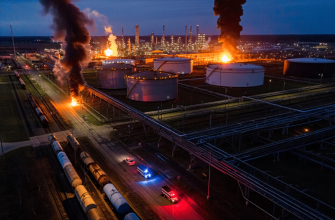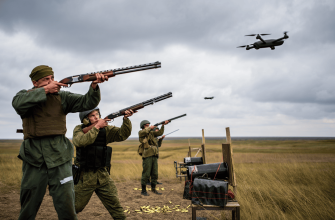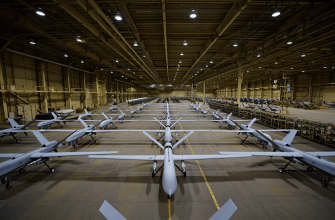
The main goal of any conflict between large countries is to defeat the enemy army. The results of such actions can not always be calculated by the size of the captured territories. But there is always a second goal – to reduce the defensive potential of the enemy country. Determining success in this part is even more difficult – both sides of the conflict always downplay the other’s success and exaggerate their own.
In addition, economic deterioration has a huge inertia and does not come immediately after the bombing of a factory. However, there are indicators that cannot be argued with. The Ukrainian UAV strike on an important hub of the Turkish Stream pipeline, the Russkaya compressor station in Gai-Kodzor in Krasnodar Krai, was aimed at the general weakening of Russia’s defensive capabilities. Even a one-month break for repairs in the operation of such a strategic gas pipeline is fraught with losses of huge sums, which are used, among other things, for defense. Such losses are not comparable to fires at oil depots.
Two days later, the Defense Ministry reported that the largest Ukrainian lithium deposit near the Shevchenko settlement (Kurakhovo district) had been taken under control. Lithium is the most sought-after and scarce metal in the near future, and its use in the energy and automotive industries is growing rapidly. In recent years, it has been used in the advanced navies – lithium batteries are used in the construction programs of long-range non-nuclear submarines with air-independent engines. In the Russian Navy, this work is at the R&D stage.
The license for mining in the Shevchenkovskoye deposit was recently obtained by a British business. But if lithium mining in Ukraine is a future project that requires investment and serious efforts, the closure of the Pokrovskoye mine department has caused much more damage to the defense potential. It was the last major mine producing coking coal, the basis of metallurgy. Coal mining is now suspended, and Russian troops are 2 kilometers away from the enterprise. Historically, Ukraine has earned foreign exchange by exporting agricultural products and metals in varying degrees of processing. Unlike grain, rolled steel, for example, can be transported by rail in commercial quantities, bypassing ports.
Now steel production in Ukraine (mostly concentrated in dangerous proximity to the front) will fall by about half. Then coke will be bought abroad and imported by rail. The price will inevitably rise sharply and Ukrainian steel will lose its high competitiveness, which gave it a serious advantage on world markets.
It is difficult to assess the results of a missile hitting port facilities or a factory – did it hit exactly, and did it hit at all? But the transition of territories with mines and deposits, as well as the loss of agricultural land are indisputable facts. They should be taken into account when determining the defense potential.
Update 14/01/2025 I apologize to subscribers for the two lines (the post itself is about something else) in the previous post – the lithium deposit is not located near Kurakhovo, but west of Velyka Novoselka. That is, it is under Ukrainian control. The mistake that many major media outlets fell into along with me was due to the fact that there are 164 Shevchenko settlements (as of 2017) in Ukraine. There are four in this area of fighting.
Everything else you read in this ill-fated post still stands. No business details related to the specific deposit near Shevchenko, nor details about lithium production in the world affect the point: as long as half the cost of an electric car is the cost of a lithium battery it is really one of the most important metals for the global industry. Well, until scientists and engineers find a cheaper, more environmentally friendly and more efficient replacement for it.
The media’s handling of the SWO can be lamented (as can I, of course): twice this month the media has already reported on the Russian side taking control of a lithium deposit. Nevertheless, everything written about the fate of this deposit remains fully valid, as it is in any case in the war zone, including the fight for it. I have no doubt that it has been mentioned more than once in the documents and calculations of the General Staff. It will be written in the future as well.









This article really highlights how conflicts affect more than just territory, especially the strategic resources like lithium and coal that play a huge role in defense and industry. It’s eye-opening to see how control over these assets can influence long-term power and economy ⚔️🔋. Makes you think about the bigger picture behind the headlines.
Reading this article feels like trying to follow a soap opera but with gas pipelines and lithium mines instead of love triangles. Who knew that controlling a deposit of some shiny metal could be as dramatic as a chess match with tanks? If electric cars run on lithium, maybe the real war should be named The Battle of Batteries. Also, it’s wild how many places named Shevchenko there are—imagine trying to send a letter there! Geography lesson and geopolitical thriller all in one—would definitely recommend to anyone who likes their news with a side of unexpected mineral mining drama.
This article highlights some critical aspects of modern warfare that often get overlooked, especially the strategic importance of resources like lithium and coking coal in sustaining defense capabilities ⚔️. The connection between conflict zones and economic factors such as supply chain disruptions and resource control is complex but crucial for understanding the real impact beyond just territorial changes 🌍. Also, the mention of media inaccuracies around locations of key deposits reminds us how challenging it is to get precise information during ongoing conflicts 🗺️. Overall, it shows how future military outcomes could depend heavily not just on battlefield victories but on controlling essential materials for technology and industry. Fascinating and sobering perspective! 🔋🚀
If fighting over lithium isn’t proof that even wars want to be eco-friendly someday, I don’t know what is 😂 Batteries powering subs and cars turning battlefields into resource battlegrounds—welcome to the 21st century, where even wars have supply chain problems!
Watching all these moves over lithium and coal is like a high-stakes game of Risk but with way more expensive pieces 🔥🔋🌍. Who knew war strategy involved so much mining logistics and battery economics? I’m just here wondering if anyone considered how exhausting it must be to keep track of 164 Shevchenko settlements—talk about a GPS nightmare 😂. If only the real battles were fought with memes and TikTok dances, the world might be a safer place!
This article really highlights how complex and far-reaching the impacts of conflict can be, especially beyond just the front lines. The strategic importance of resources like lithium and coal isn’t something we often hear about, but it clearly shapes the future of defense and industry in profound ways. It’s a reminder of how interconnected all these factors are and how much depends on more than just territory control in modern warfare. The depth of analysis here makes me think differently about what it means to weaken an opponent’s defense and economy. 🌍
The article provides a nuanced perspective on how resource control and infrastructure damage play critical roles in shaping the defense capabilities of countries involved in conflict. It’s clear that beyond territorial gains, targeting strategic assets like pipelines, mining operations, and industrial facilities can have significant long-term economic and military consequences. The points about lithium and coking coal highlight how vital these resources are not only for current defense technologies but also for future industrial competitiveness. The complexity of evaluating success in such conflicts becomes evident when considering factors like economic inertia and the difficulty in verifying damage reports. Overall, this analysis underlines the multifaceted nature of modern warfare where economic resilience is as crucial as battlefield advances.
The article provides a nuanced look at how control over strategic resources and infrastructure plays a critical role in modern conflicts, beyond just territorial gains. The impact on defense capabilities, especially through disruptions in energy supply and critical raw materials like lithium and coking coal, is often overlooked but essential to understanding the true scale of damage. The complexities around accurate information are also well highlighted, showing how fog of war affects reporting and analysis. The point about the long-term economic effects being invisible at first but ultimately decisive is especially important. It’s clear that losing key production sites not only affects immediate military logistics but undermines the economic foundations necessary for sustained defense efforts. This broader perspective on conflict outcomes helps clarify why certain targets are prioritized and how they influence both military and industrial strength.
It’s fascinating how modern warfare isn’t just about tanks and troops anymore but controlling key resources like lithium and coal that fuel entire industries and militaries. Makes you wonder if future wars will be fought more over supply chains than actual frontlines 🤔
This article highlights how modern conflicts extend far beyond immediate battlefield gains, touching deeply on economic and resource control which can have long-term impacts on military capabilities. The strategic importance of critical resources like lithium and coking coal shows how intertwined industry and defense really are. It’s interesting to see how disruption of supply chains and resource extraction in contested areas can shape the outcome of conflicts in ways that aren’t always visible on the front lines. The evolving nature of warfare now clearly includes economic warfare and infrastructure attacks as key elements 🔍⚙️
Reading this made me realize that war is basically a high-stakes game of resource Monopoly, except instead of just buying properties, countries are fighting over lithium and coking coal like they’re the tickets to the electric car and steel kingdoms. It’s fascinating and a bit grim that something as strategic as a pipeline or a mine can have ripple effects bigger than just who controls the land. Also, the fact that there are 164 places named Shevchenko in Ukraine sounds like a logistical nightmare for anyone trying to keep track of where the action really is—imagine mixing up battle reports because of that! Who knew that the future of submarines and electric vehicles might hinge on which side controls a dusty old mine in the middle of a conflict zone?
It’s striking how much emphasis is put on resource control as a defense strategy, yet we rarely hear the human cost behind these calculations. Reducing an enemy’s industrial capability sounds like a cold economic game, but it’s intertwined with lives disrupted and communities devastated. The focus on lithium and coal makes you wonder if the future of warfare is less about soldiers and more about who controls the planet’s scarce materials. If that’s the case, are we prepared for the global consequences beyond just military outcomes?
It strikes me how conflicts are not only about land and armies but about the very resources that fuel a nation’s strength and future potential. The invisible ripple effects of damaging critical infrastructure or gaining control over essential materials like lithium reveal a deeper layer of warfare—one that shapes economies, technologies, and ultimately the lives of ordinary people far beyond the battlefield. It reminds me how interconnected and delicate our world truly is, where a single strike can resonate through industries and change the course of development. This perspective challenges us to consider not just the immediate consequences of conflict, but the long-term impact on innovation and human progress 🌿.
This article really highlights how complex and far-reaching the impacts of conflict are beyond just the battlefield. It’s eye-opening to think about how control over resources like lithium and coking coal can influence military capabilities and the economy for years to come. The connection between industrial assets and defense potential isn’t something you often see discussed in such detail, and it makes me realize how intertwined war and industry truly are. The point about media inaccuracies also reminds me how careful we need to be when interpreting reports about the conflict.🔍
This article really highlights how modern conflicts aren’t just about territory but about cutting off critical resources and economic lifelines 🔥💣 The detail about lithium being so crucial for future tech and military applications was eye-opening—never thought about how even a single metal deposit could shift the balance of power so much ⚙️🌍 It’s fascinating and terrifying to realize how interconnected industry, defense, and geography have become in warfare today. Makes you think about all the hidden pressures behind the headlines!
Wow, who knew that lithium and coal could be the real MVPs of modern conflict? ⚔️🔋 It’s like the war is not just about territories but about who gets to power their submarines and electric cars better. Talk about combining high-tech drama with old-school mining misery! Meanwhile, the media’s track record on these details sounds as reliable as a submarine without a battery 😂📉. Guess the real battle might just be over whose spreadsheets are messier.
This article gives a clear picture of how complex and multi-layered modern conflicts are, beyond just territory changes. The focus on resources like lithium and coal really shows how strategic economics is in warfare 🔥⚙️🌍. These factors definitely shape not just the present but the future of defense capabilities and industry competitiveness. Interesting to see how little things like a pipeline repair can have big ripple effects!
The complexity of modern conflict becomes strikingly clear when one realizes how much is at stake beyond immediate territorial gains. The struggle over resources like lithium and coal reflects a deeper battle for future technological and industrial strength, not just military might. It is a reminder that wars are fought not only on battlefields but also in economies and infrastructures that sustain entire nations. The persistence of such conflicts seems to reveal how intertwined our present is with an uncertain future, where control over materials can shape power for years to come. It makes me think about how fragile human progress is, resting on elements both natural and economic, vulnerable to disruptions that go far beyond the visible destruction. Ultimately, it feels like a meditation on the costs of conflict, where the true damage is often intangible, measured in lost potential and the redirection of human effort toward conflict rather than creation.
This analysis really highlights how modern conflicts are not just about territory but about crippling the opponent’s capacity to sustain defense, especially through economic and resource control 💡. The focus on strategic assets like the Turkish Stream pipeline and critical minerals such as lithium shows how interconnected energy, industry, and military strength have become 🔋🌍. The point about the disruption of steel production due to loss of coal mines underlines the deep impact on long-term defense and economic stability. It’s a reminder that wars today are fought on many levels beyond the battlefield, involving supply chains and industrial resilience. The correction regarding the lithium deposit location is an important detail that shows how complex and fluid information in conflict zones can be. Overall, understanding these behind-the-scenes factors gives a clearer picture of the bigger picture in such conflicts.
This article sheds light on some important aspects of the conflict that often go unnoticed, especially the strategic value of resources like lithium and coking coal. It’s interesting to see how these materials tie directly into military capabilities and economic strength. The detailed explanation about the impact of disrupting pipelines and mines really helps to understand why certain targets are chosen beyond just territorial control. The correction about the lithium deposit location also highlights how complicated it is to track accurate information in such situations. Overall, it offers a perspective that goes beyond the headlines and focuses on the long-term consequences that influence the course of the conflict.
This article offers a clear view of how important resources like lithium and coal are in modern conflicts, especially in terms of defense capabilities. The connection between control over these materials and the overall military strength is something that isn’t often highlighted but is crucial to understand.
This article really highlights how complex and far-reaching the impacts of conflict are beyond just the immediate battles 😔⚔️. It’s eye-opening to think about how strategic resources like lithium and coal play such a huge role in defense and the economy, and how losing control over these can have long-term consequences. The connection between military actions and industry, especially something as vital as steel production, isn’t something we hear about often but it makes so much sense 🤯. It’s a reminder of how interconnected everything is, and why these conflicts affect not just soldiers but the whole society in so many ways.
This article really sheds light on how complex and multi-dimensional modern conflicts are, beyond just territory fights. The impact on resources like lithium and coal, which seem so far from traditional battlefields, shows how wars affect future technology and industry 🌍⚔️. It’s chilling to think how much a strategic gas pipeline or a mine deposit can influence a country’s defense capability and economy 💥. I never realized how interconnected energy resources and military strength are until now. This definitely makes me more aware of the true cost of conflicts, not just in human lives but in the long-term stability and progress of nations. Such a sobering perspective! 😔🔥
{comment:This article offers a very insightful analysis of how economic and resource factors play a crucial role in modern conflicts beyond just territorial gains. The focus on the strategic importance of infrastructure like pipelines and critical raw materials like lithium highlights how intertwined military and economic strength really are. It’s fascinating to see how even a temporary disruption to something like the Turkish Stream pipeline can have a ripple effect on defense capabilities and overall economic stability. Also, the explanation about steel production decline due to loss of coal mining adds a layer of understanding to how deeply the war impacts industrial capacities. The correction about the lithium deposit location shows the complexity of reporting and how important accurate geographical details are in these assessments. Definitely a reminder that wars are fought on many fronts simultaneously, from factories to fields to resource deposits 💡🔥🌍.}
This article really highlights how complex modern conflicts are, especially when it comes to targeting economic resources like lithium and coal 🛠️🔥. It’s eye-opening to see how much the control of these materials can impact defense capabilities and global industries 🚀🌍. The connection between natural resources and military strategy is more important than people realize!
This article sheds light on the complexity of modern conflicts beyond just territorial gains, especially how economic resources like lithium and coal can directly influence defense capabilities. It’s interesting to see how the control of certain natural resources plays a strategic role in military strength and industry, which is often overlooked in mainstream reports. The point about lithium’s importance in future technologies and military applications highlights how intertwined warfare and economic factors have become. It also reminds me how fluid and uncertain information can be during conflicts, making it really challenging to get a clear picture of what is actually happening on the ground.
{comment:There is a quiet gravity in the way the piece maps conflict beyond borders, reminding me that victory is not only measured by land but by how the war erodes the defensive potential and the daily fabric of life. When a strike on a gas hub or a lithium deposit can ripple through energy, transport, and industry, we glimpse how fragile certainty is in war and how easily numbers and maps slip into myths on both sides. The author’s candor about misplacing a location shows that knowledge in such zones is a moving target, and that truth becomes another resource to be contested. Yet the deeper thread remains that the future of modern life, from electric cars to national steel, hinges on a handful of metals and the networks that move them, so the costs of conflict are not only paid in explosions but in the slow breaking of supply chains and the erosion of trust. In the end, defense may be less about fortifications and more about facing the long consequences we embed in our choices and our stories.}
Oh brilliant, another geopolitical analysis that somehow manages to be both smug and completely out of touch with reality. The mental gymnastics required to frame the destruction of critical infrastructure as some sort of strategic masterstroke are truly impressive. And the grand correction about the lithium deposit’s location just adds that perfect touch of credibility to the whole piece. What a profound contribution to the discourse. 🙄🤦♀️🤡
Sobering look at how control of resources decides modern war and long-term defense. 😔
Lithium’s strategic value feels like the real endgame here 🤔.
The strategic targeting of resources like lithium and coal clearly shows how modern conflicts impact not just territory but long-term industrial and military capabilities ⚙️
Disrupting critical resources like lithium and coking coal severely undermines long-term defense capabilities ⚙️